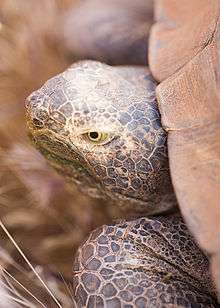Hesperotestudo
Hesperotestudo ("Western turtle") is an extinct genus of tortoise that lived from the Miocene to the Pleistocene. Its remains are known from North America, Central America and Bermuda.[1][2] Further specimens identifiable only to genus have been found in El Salvador (TEWG, 2015).[3]
| Hesperotestudo Temporal range: Miocene-Late Pleistocene | |
|---|---|
 | |
| Hesperotestudo orthopygia | |
| Scientific classification | |
| Kingdom: | Animalia |
| Phylum: | Chordata |
| Class: | Reptilia |
| Order: | Testudines |
| Suborder: | Cryptodira |
| Superfamily: | Testudinoidea |
| Family: | Testudinidae |
| Genus: | †Hesperotestudo Williams, 1950 |
Taxonomy
Species list is based on Rhodin et al. 2015[3] Note: List includes only Pleistocene species
- † Hesperotestudo Williams 1950[4]
- Eupachemys Leidy 1877 (nomen oblitum)
- Hesperotestudo Williams 1950:25
- Caudochelys Auffenberg 1963:69
- †Hesperotestudo annae (Hay 1923)[5]
- Testudo annae Hay 1923:114 (Early Pleistocene, Irvingtonian, US (Texas))
- Testudo francisi Hay 1923:116 [Early Pleistocene, US (Texas)]
- Testudo annae Hay 1923:114 (Early Pleistocene, Irvingtonian, US (Texas))
- †Hesperotestudo bermudae Meylan and Sterrer 2000[1]
- Hesperotestudo bermudae Meylan and Sterrer 2000:51 [Middle Pleistocene, Bermuda], c. 310,000 years before present (YBP) - Size: CL c. 50 cm
- †Hesperotestudo campester (Hay 1908)[6]
- Testudo campester Hay 1908:455 [Late Pliocene to Early Pleistocene, Blancan, US (Texas)] - Size: CL c. > 100 cm
- Testudo rexroadensis Oelrich 1952:301 [Late Pliocene, Early Blancan, US (Kansas)]
- Testudo campester Hay 1908:455 [Late Pliocene to Early Pleistocene, Blancan, US (Texas)] - Size: CL c. > 100 cm
- †Hesperotestudo crassiscutata (Leidy 1889)[7]
- Eupachemys obtusus Leidy 1877:232 (Pleistocene, US (South Carolina)) (nomen oblitum) - Size: CL c. 120–125 cm
- Eupachemys rugosus Leidy 1889:29 (Late Pleistocene– Early Holocene, Rancholabrean, US (Florida)) (ex errore for Eupachemys obtusus)
- Testudo crassiscutata Leidy 1889b:31 [Late Pleistocene– Early Holocene, Rancholabrean, US (Florida)], 14C age: 12,030 ± 200 YBP, calibrated age*: 12,896–11,465 YBP (10,946 BC–9515 BC)
- †Hesperotestudo equicomes (Hay 1917) [9]
- Testudo equicomes Hay 1917:41 (Late Pleistocene, Rancholabrean, Sangamonian, US (Kansas)) - Size: CL c. 34 cm
- †Hesperotestudo incisa (Hay 1916)[8]
- Testudo incisa Hay 1916:46 (Late Pleistocene, Rancholabrean, Sangamonian, US (Florida)) - Size: CL c. 29 cm
- †Hesperotestudo johnstoni (Auffenberg 1962)[10]
- Geochelone johnstoni Auffenberg 1962:627 (Early Pleistocene, Late Blancan, Pre-Nebraskan glaciation, US (Texas)) - Size: CL c. 24 cm
- †Hesperotestudo mlynarskii (Auffenberg 1988)[11]
- Geochelone mlynarskii Auffenberg 1988:592 (Middle Pleistocene, Late Irvingtonian, US (Florida)) - Size: CL c. 20 cm
- †Hesperotestudo oelrichi (Holman 1972)[12]
- Geochelone (Hesperotestudo) oelrichi Holman 1972:59 (Pleistocene, Long Pine and Keim Formations, Pre-Nebraskan glaciation, US (Nebraska)) - Size: CL c. 28 cm
- †Hesperotestudo percrassa (Cope 1899)[13]
- Clemmys percrassus Cope 1899:194 [Middle Pleistocene, Late Irvingtonian, US (Pennsylvania: Port Kennedy)] - Size: “not large”
- †Hesperotestudo turgida (Cope 1892)[14]
- Testudo turgida Cope 1892:127 (Late Pliocene to Early Pleistocene, Blancan, US, Texas), (Early Pleistocene) - Size: CL c. 23 cm
- †Hesperotestudo wilsoni (Milstead 1956)[15]
- Testudo wilsoni Milstead 1956:168 (Late Pleistocene, Late Wisconsinan, US (Texas)], 14C age: c. 11,040 YBP, 9090 BC,(Late Pleistocene to Early Holocene, until c. 9050 BC, c. 11,000 YBP) - Size: CL c. 23 cm
gollark: A large nuclear bomb? The bots will presumably be hardened against anything short of being destroyed directly anyway.
gollark: What could POSSIBLY go wrong?
gollark: 9 persons? How does THAT work?
gollark: I mean generally speaking.
gollark: How is such a crazy polity or whatever still around then?
References
- Meylan, P. A.; Sterrer, W. (January 2000). "Herperotestudo (Testudines: Testudinidae) from the Pleistocene of Bermuda, with comments on the phylogenetic position of the genus". Zoological Journal of the Linnean Society. 128 (1): 51–76. doi:10.1111/j.1096-3642.2000.tb00649.x.
- Olson, S. L.; Meylan, P. A. (December 2009). "A Second Specimen of the Pleistocene Bermuda Tortoise, Hesperotestudo bermudae Meylan and Sterrer". Chelonian Conservation and Biology. 8 (2): 211–212. doi:10.2744/CCB-0766.1. Retrieved 2012-04-12.
- Rhodin, A.G.J.; Thomson, S.; Georgalis, G.; Karl, H.-V.; Danilov, I.G.; Takahashi, A.; de la Fuente, M.S.; Bourque, J.R.; Delfino M.; Bour, R.; Iverson, J.B.; Shaffer, H.B.; van Dijk, P.P.; et al. (Turtle Extinctions Working Group) (2015). "Turtles and tortoises of the world during the rise and global spread of humanity: first checklist and review of extinct Pleistocene and Holocene chelonians" (PDF). Chelonian Research Monographs. 5(8):000e.1–66. doi:10.3854/crm.5.000e.fossil.checklist.v1.2015.
- Williams , E.E. 1950. Testudo cubensis and the evolution of Western Hemisphere tortoises. Bulletin of the American Museum of Natural History 95:1–36.
- Hay, O.P. 1923. Characteristics of sundry fossil vertebrates. Pan-American Geologist 39:114–120.
- Hay, O.P. 1908. The Fossil Turtles of North America. Carnegie Institution of Washington, Publication 75:1–568.
- Leidy, J. 1889. Description of vertebrate remains from Peace Creek, Florida. Transactions of the Wagner Free Institute of Science of Philadelphia 2:19–31.
- Hay, O.P. 1916. Descriptions of some Floridian fossil vertebrates, belonging mostly to the Pleistocene. Annual Report of the Florida State Geological Survey 8:39–76.
- Hay, O.P. 1917. On a collection of fossil vertebrates made by Dr. F.W. Dragin in the Equus beds of Kansas. Kansas University Science Bulletin 10:39–51.
- Auffenberg, W. 1962. A new species of Geochelone from the Pleistocene of Texas. Copeia 1962(3):627–636.
- Auffenberg, W. 1988. A new species of Geochelone (Testudinata: Testudinidae) from the Pleistocene of Florida (U.S.A.). Acta Zoologica Cracoviensia 31:591–604.
- Holman, J.A. 1972. Amphibians and reptiles. In: Skinner, M.F. and Hibbard, C.W. (Eds.). Early Pleistocene pre-glacial and glacial rocks and faunas of north-central Nebraska. Bulletin of the American Museum of Natural History 148(1):55–148.
- Vertebrate remains from Port Kennedy bone deposit. Journal of the Academy of Natural Sciences, Philadelphia (2)11:193–267.
- Cope, E.D. 1892. A contribution to the vertebrate palaeontology of Texas. Proceedings of the American Philosophical Society 30:123–131.
- Milstead , W.W. 1956. Fossil turtles of Friesenhahn Cave, Texas, with the description of a new species of Testudo. Copeia 1956(3):162–171.
This article is issued from Wikipedia. The text is licensed under Creative Commons - Attribution - Sharealike. Additional terms may apply for the media files.
